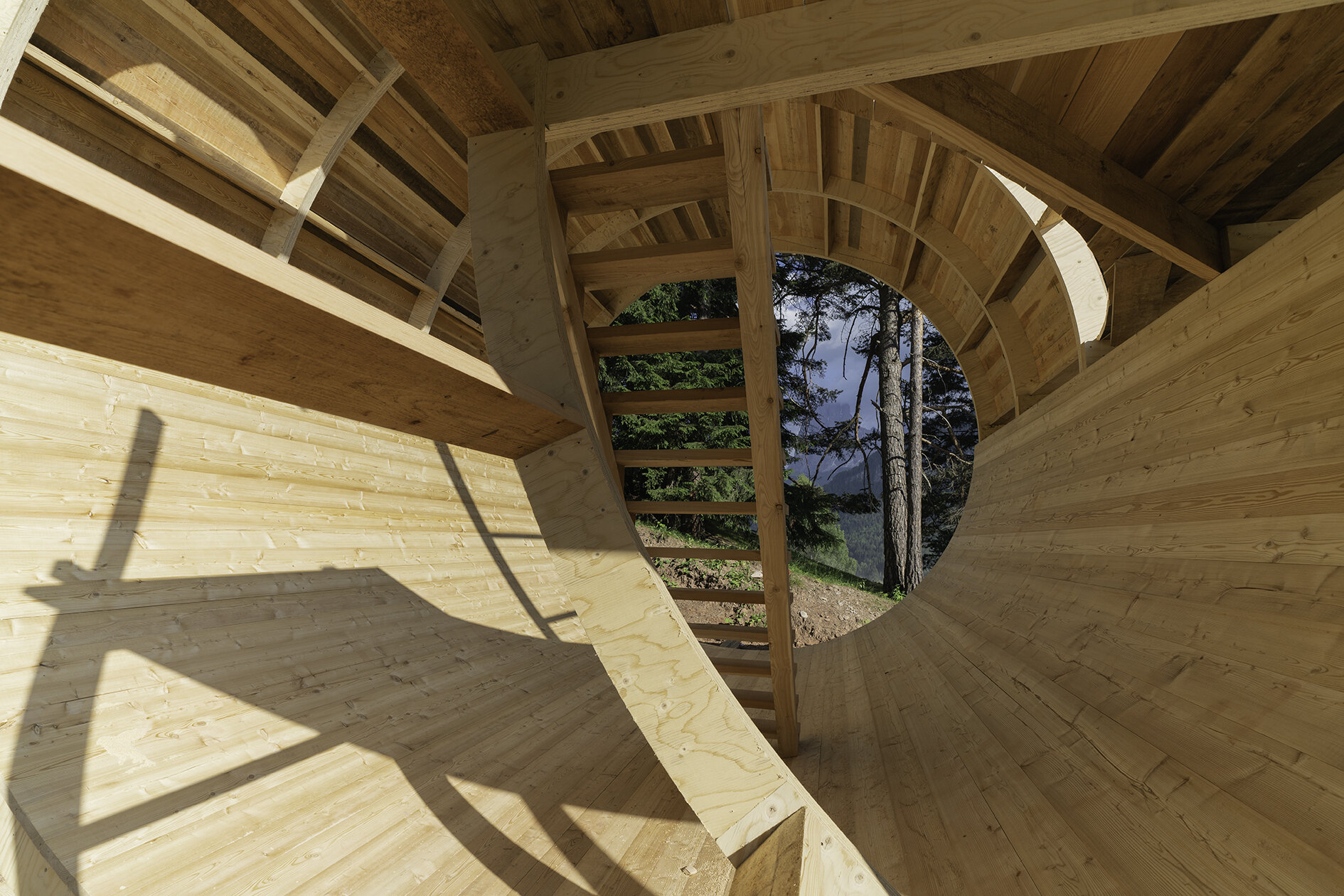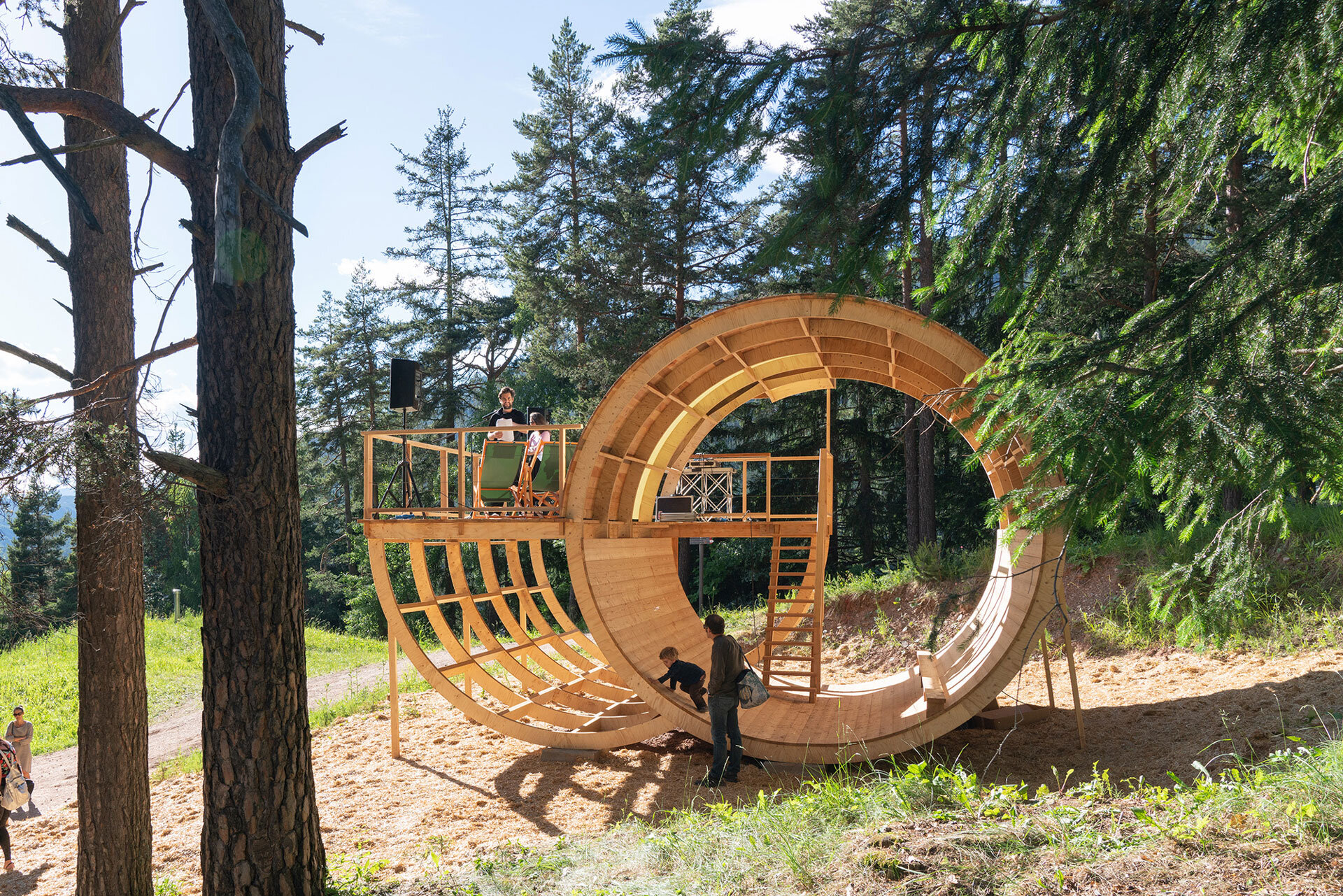
Jiří Příhoda
*1966, Czech Republic
lives and works in Prague, Czech Republic and Austin, Texas, USA
EN
Jiří Příhoda’s Diogenes’ Barrel (Poetry Pavilion), conceived for the 6th Biennale Gherdëina, is both a chamber of contemplation as well as a performance space for the readings of poetry, written and composed by Alessandro De Francesco. Doubled cylindric structure reflects the dialectics of inside and outside, rendering simultaneously open and enclosed space, a sanctuary within a breathtaking scenery of the Val Gardena’s Col De Flam with a carefully framed view towards the mythical Sassolungo. Executed mostly of wood, the pavilion’s roof is made of a luminescent artificial stoneware Corralit, absorbing daylight and glowing in the dark, thus generating a magical effect on long Summer evenings and nights. Named Diogenes’ Barrel after eccentric Greek philosopher’s infamous dwelling of a large ceramic jar in the marketplace, Příhoda’s structure is a modest but, at the same time, unique and brave proposal of an all-immersive spatial environment which boldly rewrites the vernacular language while retaining a respect for the local tradition and style. As such, in a spirit of Diogenes - an exile and an outcast, a man with no social identity - who was credited with the first known use of the word “cosmopolitan” and who used to call himself "a citizen of the world”, the pavilion is a tribune for poetry as a medium practicing an universal language, a medium which is considered by Franco Bifo Berardi as “a hidden resource that enables us to shift from one paradigm to another”.
IT
Concepita appositamente per la sesta edizione della Biennale Gherdëina, l’opera Diogenes’ Barrel (Poetry Pavilion) è sia un luogo di meditazione che uno spazio performativo per la lettura della poesia scritta da Alessandro De Francesco. Una doppia struttura cilindrica riflette la dialettica tra interno ed esterno, creando spazi sia aperti che chiusi, un santuario nello scenario mozzafiato del Col de Flam della Val Gardena, con una vista appositamente ritagliata sul quel luogo mitologico che è il Sasso Lungo. Mentre il padiglione è realizzato per lo più in legno, il tetto è invece assemblato con una pietra artificiale luminescente (Corralit), che assorbe la luce diurna e la rilascia al buio, generando un effetto magico nelle lunghe serate e notti estive. Il titolo Diogenes’ Barrel fa riferimento al famigerato aneddoto secondo il quale l’eccentrico filosofo greco viveva in una grande botte della piazza del mercato; la struttura realizzata da Příhoda si propone come modesto, ma allo stesso tempo unico e coraggioso ambiente spaziale completamente immersivo, che riscrive audacemente il linguaggio volgare mantenendo però sempre un rispetto per la tradizione e lo stile locali. E quindi, fedele allo spirito di Diogene - un esiliato ed emarginato, uomo senza identità sociale, a cui si attribuisce il primo utilizzo conosciuto del termine “cosmopolita”, e che era solito descriversi come “cittadino del mondo” - il padiglione è una piattaforma per la poesia, vista come mezzo artistico che si esprime con un linguaggio universale, un mezzo che Franco Bifo Berardi considera “una risorsa nascosta che ci consente di passare da un paradigma all’altro”.
DE
Jiří Příhodas Werk Diogenes’Barrel (Poetry Pavilion), das für die 6. Biennale Gherdëina konzipiert wurde, ist beides: ein Ort der Kontemplation und ein Vorführungsort für Lesungen von Gedichten, die von Allessandro De Francesco geschrieben und komponiert wurden. Die doppelte zylindrische Struktur reflektiert die Dialektik von Innen und Außen und erschafft gleichzeitig offenen und geschlossenen Raum, der Pavillon ist Zufluchtsort in der atemberaubenden Landschaft des Col De Flam in Val Gardena mit einem sorgfältig umrahmten Blick auf den mythischen Langkofel.
Das Dach des Pavillons, der ansonsten hauptsächlich aus Holz gebaut ist, besteht aus leuchtendem Corralit, einem künstlichen Steinmaterial, das das Tageslicht absorbiert und im Dunkeln leuchtet, und so in langen Sommernächten magisch anmutet. Příhodas Werk Diogenes’ Barrel ist nach der berühmten Behausung des griechischen Philosophen benannt, der in einem großen Keramikfass auf dem Marktplatz wohnte, und es ist ein zugleich schlichter wie einzigartiger und mutiger Entwurf für eine alles umfassende räumliche Idee, die kühn die einheimische Sprache umschreibt, während sie den Respekt für die Tradition und den Stil des Ortes nicht verliert. Und so, im Geiste von Diogenes – einem Exilanten und Ausgestoßenen ohne soziale Identität, dem die erste Verwendung des Wortes „Kosmopolit“ zugeschrieben wird und der sich selbst als „Bürger der Welt“ bezeichnete – ist der Pavillon eine Würdigung an die Poesie. Einem Medium, das eine universale Sprache nutzt und das von Franco Bifo Berardi als „versteckte Ressource, die es uns möglich macht, von einem Paradigma ins nächste zu wechseln“ bezeichnet wurde.





